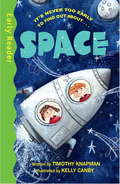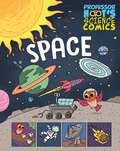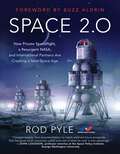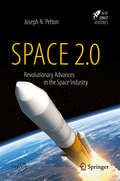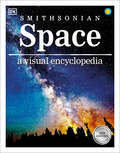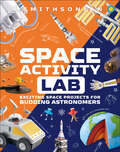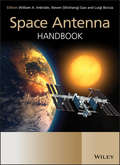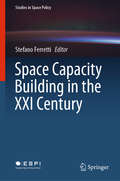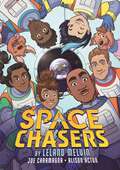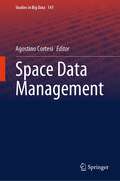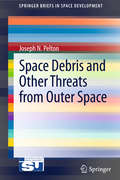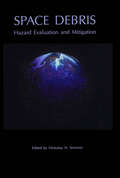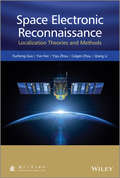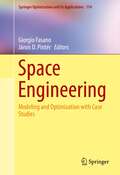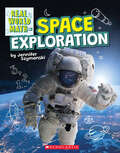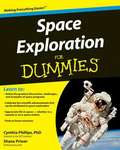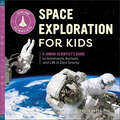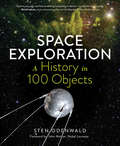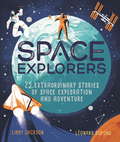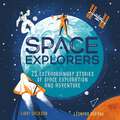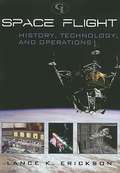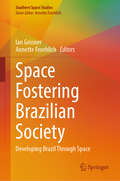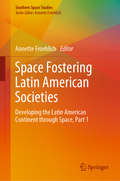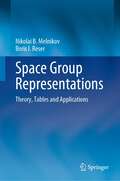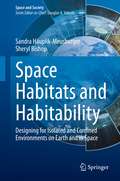- Table View
- List View
Space (Early Reader Non Fiction)
by Timothy KnapmanEarly Readers are stepping stones from picture books to reading books. A green Early Reader is a first factbook.Come and explore outer space. . .There are so many things to see - ride in a space ship to visit stars, galaxies and planets!Discover the Universe around you in this brand new non fiction Early Reader from Timothy Knapman, with full colour illustrations from Kelly Canby on every page.
Space (Professor Hoot's Science Comics #6)
by Minerva BlackEvery day brings a new adventure for Professor Hoot - and a new learning experience. Have you ever gazed at the night sky and wondered what else was out there among the stars? Professor Hoot hops aboard a rocket to find out all about space travel, the wonders of our solar system and takes a side trip to Mars to join the rovers in their exploration. Discover a great expanse of stars, satellites - and science. An entertaining comic strip approach to KS1 science topics, Professor Hoot's Science Comics are accessible and full of fun. Each book is an adventure and a chance for readers to learn something new, before testing their knowledge at the end of each book in Professor Hoot's quiz. Collect each adventure: Big Machines; Dangerous Animals; Dinosaurs; Robots and AI; Space; Volcanoes and Earthquakes.
Space 2.0: How Private Spaceflight, a Resurgent NASA, and International Partners are Creating a New Space Age
by Rod PyleWe're on the cusp of new era in the great adventure of space exploration. More than a half-century ago, humanity first hurled objects into space, and almost 50 years ago, astronauts first walked on the moon. Since then, we have explored Earth's orbit with shuttles, capsules, and space stations; sent robots to Mars, Venus, Mercury, Jupiter, Saturn, and Uranus; sampled a comet; sent telescopes into orbit; and charted most of our own planet. What does the future hold? In Space 2.0, space historian Rod Pyle, in collaboration with the National Space Society, will give you an inside look at the next few decades of spaceflight and long-term plans for exploration, utilization, and settlement. No longer the exclusive domain of government entities such as NASA and other national agencies, space exploration is rapidly becoming privatized, with entrepreneurial startups building huge rocket boosters, satellites, rocket engines, asteroid probes, prospecting craft, and even commercial lunar cargo landers to open this new frontier. Research into ever more sophisticated propulsion and life support systems will soon enable the journey to Mars and destinations deeper in our solar system. As these technologies continue to move forward, there are virtually no limits to human spaceflight and robotic exploration. While the world has waited since the Apollo lunar program for the next "giant leap," these critical innovations, most of which are within our grasp with today's technology, will change the way we live, both in space and on Earth. A new space age—and with it, a new age of peace and prosperity on Earth, and settlement beyond our planet—can be ours. Speaking with key leaders of the latest space programs and innovations, Pyle shares the excitement and promise of this new era of exploration and economic development. From NASA and the Russian space agency Roscosmos, to emerging leaders in the private sector such as SpaceX, Blue Origin, Moon Express, Virgin Galactic, and many others, Space 2.0 examines the new partnerships that are revolutionizing spaceflight and changing the way we reach for the stars.
Space 2.0: Revolutionary Advances in the Space Industry (Springer Praxis Books)
by Joseph N. PeltonA true revolution has rocked the space industry, as Silicon Valley and new startup companies around the world have shaken up the status quo. This has in turn triggered a hefty response among traditional aerospace companies, launching the sector into the new Space 2.0. This book explains how and why this remarkable change has happened, starting from the industry’s origins during the Space Age and working its way to the present day. No other industry in the world has experienced the dramatic shift in technology and services as rapidly as the field of satellite services and rocket launch systems has. This book analyzes the dynamic shift over the past decade in how satellites are designed, manufactured, launched, and operated. It also turns an eye to the future, discussing the amazing feats and potential issues we can expect from this shifting arena by 2030. With its beginner-friendly writing style and plethora of illustrations, this book serves as a perfect introductory text to students and professionals alike wishing to learn more about the key trends in the field of space applications and launch systems.
Space A Visual Encyclopedia (DK Children's Visual Encyclopedias)
by DKFrom the Moon, Sun, and planets of our Solar System to space exploration, black holes, and dark matter, this completely revised and updated children&’s encyclopedia covers all you need to know about the cosmos. The most up-to-date images from space agencies such as NASA and ESA combine with info panels, timelines, interviews, diagrams, and activities you can do at home to help you understand the majesty and wonder of space. Learn about the Space Race, the Apollo Moon Landings, the Voyager craft that first probed the outer planets, the Hubble telescope, and the International Space Station (ISS) – the state-of-the-art laboratory orbiting Earth. Find out about future missions, space tourism, and the latest discoveries in the furthest reaches of our galaxy. Discover how to find constellations and where to look for stars and planets, including Venus and Mars, in the night sky. Learn how galaxies such as our Milky Way were formed. Part of a series of best-selling encyclopedias for children, Space: A Children&’s Encyclopedia is a rocket ride from the beginning of time to the near future, and from planet Earth out to the furthest reaches of the Universe.
Space Activity Lab (DK Activity Lab)
by DKDiscover the wonders of our incredible Universe.This fun, fact-filled book is brimming with exciting outdoor experiments to help budding astronomers aged 9+ explore the secrets of space. Using household items, combine astronomy with art and craft by launching your own rocket, build a moon lander to learn how astronauts touch down safely on the moon&’s surface, and make a pinhole camera to observe a solar eclipse.Packed with photography, easy-to-follow instructions, and attention to detail, Space Activity Lab will make young astronomers excited from the get-go! Each of the super-fun make-and-do projects in this book comes with simple step-by-step photographs and instructions that will inspire children&’s imagination and reveal some of the secrets of space.This children&’s craft book on space offers: - 19 hands-on projects that appeals to kids aged 9+.- Materials easily found around the home with no specialist equipment needed.- Information boxes full of fascinating facts and panel stories that explain the science throughout the book.- A clear explanation how STEM is involved in creating the project or the results of the experiment.Perfect for kids who are interested in STEM, Space Activity Lab features projects that explore everything from the Solar System to meteorites and from the Milky Way to moon buggies. Design your own orrery to understand how planets orbit the Sun, create a cardboard model to explore the phases of the moon, and for when darkness falls, there&’s a starfinder section that shows you how to spot incredible constellations in the night sky, from The Plough to Orion.More in the seriesThe Activity Lab series inspires children to get hands-on with learning by creating exciting STEM projects in their favorite subject. If you liked Space Activity Lab, then why not try Dinosaur Activity Lab for budding palaeontologists, Cardboard Activity Lab for eco-friendly recycling fun, or Great STEM Projects experiments for all budding scientists?
Space Antenna Handbook
by Steven Shichang Gao William A. Imbriale Luigi BocciaThis book addresses a broad range of topics on antennas for space applications. First, it introduces the fundamental methodologies of space antenna design, modelling and analysis as well as the state-of-the-art and anticipated future technological developments. Each of the topics discussed are specialized and contextualized to the space sector. Furthermore, case studies are also provided to demonstrate the design and implementation of antennas in actual applications. Second, the authors present a detailed review of antenna designs for some popular applications such as satellite communications, space-borne synthetic aperture radar (SAR), Global Navigation Satellite Systems (GNSS) receivers, science instruments, radio astronomy, small satellites, and deep-space applications. Finally it presents the reader with a comprehensive path from space antenna development basics to specific individual applications. Key Features: Presents a detailed review of antenna designs for applications such as satellite communications, space-borne SAR, GNSS receivers, science instruments, small satellites, radio astronomy, deep-space applications Addresses the space antenna development from different angles, including electromagnetic, thermal and mechanical design strategies required for space qualification Includes numerous case studies to demonstrate how to design and implement antennas in practical scenarios Offers both an introduction for students in the field and an in-depth reference for antenna engineers who develop space antennas This book serves as an excellent reference for researchers, professionals and graduate students in the fields of antennas and propagation, electromagnetics, RF/microwave/millimetrewave systems, satellite communications, radars, satellite remote sensing, satellite navigation and spacecraft system engineering, It also aids engineers technical managers and professionals working on antenna and RF designs. Marketing and business people in satellites, wireless, and electronics area who want to acquire a basic understanding of the technology will also find this book of interest.
Space Capacity Building in the XXI Century (Studies in Space Policy #22)
by Stefano FerrettiThis book, edited by the European Space Policy Institute, is the first international publication, following UNISPACE+50, to analyze how space capacity building can empower the international community towards fully accessing all the economic and societal benefits that space assets and data can offer. New innovation models are increasingly spreading across various sectors and disciplines, including space, which is becoming an integral part of many societal activities (e.g. telecoms, weather, climate change and environmental monitoring, civil protection, infrastructures, transportation and navigation, healthcare and education). The book helps readers construct their own space capacity building roadmaps, which take into account key stakeholders and also new private actors, NGOs and civil society. Starting from a policy and strategy perspective, it addresses key aspects of capacity building, including innovation and exploration, global health, climate change and resilient societies. It outlines the available options and summarizes the ideal programmatic conditions for their successful implementation. Showcasing reflections from a range of senior space professionals around the world, with their unique perspectives and solutions, it provides a rich mosaic in which various cultural and policy approaches to space are translated into actionable programs and ideas so that space may truly benefit all of humankind.
Space Chasers by Leland Melvin (Space Chasers by Leland Melvin)
by Leland Melvin Joe CaramagnaWhen a team of brilliant kids-turned-astronauts find themselves in serious trouble in outer space, they must work together to get back home. This is the first book in an incredible middle-grade graphic novel series created by real life astronaut, Leland Melvin!Launch into action in T-Minus 3, 2, 1… When Tia Valor takes a test on a whim for an exclusive NASA program for middle schoolers, she never thought she’d pass. After all, she never really fit in at school. In fact, she’s been skipping school most days to work at her brother’s auto shop instead. But Leland Melvin, a famed astronaut, sees potential in Tia, and before she knows it, she’s part of a team of other talented kids training to launch to an advanced space station orbiting the earth. But the perils of space are unpredictable and Tia finds herself with only half her crew and no adults around to help. Now she must rely on her instincts and the quick thinking of her fellow kid astronauts to save the space station and their lives!Created by real-life astronaut Leland Melvin, Eisner-Award nominated comic creator Joe Caramagna, and brought to brilliant life by Alison Acton, SPACE CHASERS is a space adventure like no other.
Space Data Management (Studies in Big Data #141)
by Agostino CortesiThe book presents latest results pertaining to challenges faced by researchers in space data management. There are large number of highly important applications that currently rely upon data from satellites and space missions, ranging from weather prediction to monitoring of environmental pollution, climate change, marine traffic, agriculture, and urban planning, etc. The quality and quantity of space data poses new and specific challenges to the scientific community, covering the entire life cycle of space data management and with a need for an interdisciplinary approach. The chapters written by experts discusses impacts of these challenges, and report activities that can stimulate new research.
Space Debris and Other Threats from Outer Space
by Joseph N. PeltonThe mounting problem of space debris in low earth orbit and its threat to the operation of application satellites has been increasingly recognized as space activities increase. The efforts of the Inter Agency Space Debris Coordinating Committee (IADC) and UN COPUS have now led to international guidelines to mitigate the creation of new debris. This book discusses the technical studies being developed for active removal processes and otherwise mitigating problems of space debris, particularly in low earth orbit. This book also considers threats to space systems and the Earth that comes from natural causes such as asteroids, coronal mass ejections, and radiation. After more than half a century of space applications and explorations, the time has come to consider ways to provide sustainability for long-term space activities.
Space Debris: Hazard Evaluation and Debris
by Nickolay N. SmirnovWhen the first sputnik was launched and the space era began, few gave thought to the possible negative impact of putting satellites into orbit. In fact, man's space activity has led to the formation of a new media named "space debris," i.e. man-made objects and their fragments launched into space, currently inactive and no longer serving any useful
Space Electronic Reconnaissance
by Qiang Li Fucheng Guo Yun Fan Caigen Xhou Yiyu ZhouPresents the theories and applications of determining the position of an object in space through the use of satellitesAs the importance of space reconnaissance technology intensifies, more and more countries are investing money in building their own space reconnaissance satellites. Due to the secrecy and sensitivity of the operations, it is hard to find published papers and journals on the topic outside of military and governmental agencies. This book aims to fill the gap by presenting the various applications and basic principles of a very modern technology. The space electronic reconnaissance system in mono/multi-satellite platforms is a critical feature which can be used for detection, localization, tracking or identification of the various kinds of signal sources from radar, communication or navigation systems.Localization technology in space electronic reconnaissance uses single or multiple satellite receivers which receive signals from radar, communication and navigation emitters in the ground, ocean and space to specify the location of emitter. The methods, principles and technologies of different space electronic reconnaissance localization systems are introduced in this book, as are their performances, and the various methods are explained and analysed. Digital simulations illustrate the results.Presents the theories and applications of determining the position of an object in space through the use of satellitesIntroduces methods, principles and technologies of localization and tracking in the space electronic reconnaissance system, the localization algorithm and error in satellite system and near space platform system, and the tracking algorithm and error in single satellite-to-satellite tracking systemProvides the fundamentals, the mathematics, the limitations, the measurements, and systems, of localization with emphasis on defence industry applicationsHighly relevant for Engineers working in avionics, radar, communication, navigation and electronic warfare.Chapters include:- the introduction of space electronic reconnaissance localization technology, knowledge about the satellite orbit and basic terminology of passive localization, single satellite geolocation technology based on direction finding, three-satellite geolocation technology based on time difference of arrival (TDOA), two-satellite geolocation technology based on TDOA and frequency difference of arrival (FDOA), the single satellite localization technology based on kinematics theory, localization principles of near-space platform electronic reconnaissance systems, the orbit determination of single satellite-to-satellite tracking using bearings only(BO) information, the orbit determination of single satellite-to-satellite tracking using bearings and frequency information, the orbit determination of single satellite-to-satellite tracking using frequency only(FO) information. Each chapter ends with a problem and solution section, some using Matlab code.
Space Engineering
by Giorgio Fasano János D. PintérThis book presents a selection of advanced case studies that cover a substantial range of issues and real-world challenges and applications in space engineering. Vital mathematical modeling and numerical solution aspects of each application case study are presented in detail, with discussions of a range of advanced model development and solution techniques and tools. Space engineering challenges are discussed in the following contexts: *model space vehicle design *computation of optimal low thrust transfers *indirect optimization of spacecraft trajectories *resource-constrained scheduling, *packing problems in space *design of complex interplanetary trajectories *satellite constellation image acquisition *re-entry test vehicle configuration selection *collision risk assessment on perturbed orbits *optimal robust design of hybrid rocket engines *nonlinear regression analysis in space engineering *regression-based sensitivity analysis and robust design *low-thrust multi-revolution orbit transfers *modeling and optimization of balance layout problems *pilot-induced oscillations alleviation *modeling and optimization of hybrid transfers to near-Earth objects *probabilistic safety analysis of the collision between space debris and satellite *flatness-based low-thrust trajectory optimization for spacecraft proximity operations The contributing authors are expert researchers and practitioners in either the space engineering and/or in the applied optimization fields. Researchers and practitioners working in various applied aspects of space engineering will find this book practical and informative. Academics, graduate and post-graduate students in aerospace engineering, applied mathematics, operations research, optimization, and optimal control, will find this book useful.
Space Exploration (Real World Math)
by Jennifer SzymanskiGrab your space suit and get ready to use math to explore space!3 … 2 … 1 … blast off! Space scientists use math every day to explore our universe. Join a real astronomer on an amazing adventure to COUNT the planets, MEASURE the stars, ADD on the space station, and more. Then test your math skills with special You Can Do It challenges.This brand-new series demonstrates how math skills can be applied to high-interest topics and careers in Coding, Building, Tracking Animals, and Space Exploration. The K-2 math concepts include counting 1-100 with basic addition and subtraction, using the power of 10, measuring, and simple geometry. Real world scientists, architects, programmers, and mathematicians model hands-on, from-the-field experiences in a way that will make children excited to use and expand their math skills!
Space Exploration For Dummies
by Cynthia Phillips Shana PriwerYour comprehensive guide to remarkable achievements in space Do you long to explore the universe? This plain-English, fully illustrated guide explains the great discoveries and advancements in space exploration throughout history, from early astronomers to the International Space Station. You'll learn about the first satellites, rockets, and people in space; explore space programs around the world; and ponder the controversial question: Why continue to explore space? Take a quick tour of astronomy - get to know the solar system and our place in the galaxy, take a crash course in rocket science, and live a day in the life of an astronaut Run the Great Space Race - trace the growth of the Space Age from Sputnik to the Apollo moon landings and meet the robots that explored the cosmos Watch as space exploration matures - from the birth of the Space Shuttle to the creation of the Mir Space Station to successes and failures in Mars exploration, see how space programs reached new levels Journey among the planets - check out the discoveries made during historic voyages to the inner and outer reaches of the solar system Understand current exploration - review the telescopes in space, take a tour of the International Space Station, and see the latest sights on Mars Look into the future - learn about upcoming space missions and increased access to space travel Open the book and find: Descriptions of space milestones and future missions An easy-to-follow chronological structure Color and black-and-white photos The nitty-gritty details of becoming an astronaut A grand tour of the solar system through space missions Explanations of tragedies and narrow escapes Facts on the creation of space stations by NASA and the USSR Ten places to look for life beyond Earth
Space Exploration for Kids: A Junior Scientist's Guide to Astronauts, Rockets, and Life in Zero Gravity (Junior Scientists)
by Bruce BettsExplore deep space and beyondGet ready to take a thrilling journey to the farthest reaches of the universe. Space Exploration for Kids is loaded with out-of-this-world facts and eye-popping photographs that give you an inside look into the daily lives of astronauts. From learning the history of space exploration and rockets to what life is like up there, this top choice among space books for kids 6-9 will inspire you to reach for the stars.Discover what it takes to become an astronaut in this informative selection in space books for kids 6-9. Included are sections about training, how space affects the human body, and the type of work they conduct. Learn about different types of crewed spacecraft, and find out how to design your own rocket ship! Your first step toward a rocket-fueled adventure begins right now.This standout among space books for kids 6-9 includes:Reach for the stars—One of the most engaging space books for kids 6-9 takes you beyond the solar system and into deep space.Astronaut 101—From astronaut training to living in space, there's a special focus on astronauts and space travel.Learn more!—A selection of bonus materials like sidebars, fun activities, and callouts make your learning experience even more fun.Go beyond other space books for kids 6-9 with this informative book about the final frontier.
Space Exploration—A History in 100 Objects: A History In 100 Objects
by Sten OdenwaldThis is no ordinary space book. Within the pages of this eclectic pop-history, scientist and educator Sten Odenwald at NASA examines 100 objects that forever altered what we know and how we think about the cosmos. From Sputnik to Skylab and Galileo’s telescope to the Curiosity rover, some objects are iconic and some obscure—but all are utterly important. The Nebra sky disk (1600 BCE) features the first realistic depiction of the Sun, Moon, and stars.The Lunar Laser Ranging RetroReflector finally showed us how far we are from the Moon in 1969.In 1986, it was the humble, rubber O-ring that doomed the space shuttle Challenger.The Event Horizon Telescope gave us our first glimpse of a black hole in 2019. These 100 objects, as Odenwald puts it, showcase “the workhorse tools and game-changing technologies that have altered the course of space history . . . the tools and devices that, taken together, represent the major scientific discoveries—and celebrate the human ingenuity—of space technology, showing the ways physics and engineering have brought about our greatest leaps in understanding the way our universe works. . . . They make it clear that we have made giant strides in our quest to search ever more deeply into the farthest reaches of the universe—and behind each new discovery is an object that expands our appreciation of space as well as the boundless imagination and resourcefulness we carry within us.”
Space Explorers: 25 extraordinary stories of space exploration and adventure
by Libby JacksonA collection of amazing real-life stories about space exploration and adventure.Do you know the true story of ...*The first astronauts to land on the moon and were nearly stranded there for ever, if it hadn't been for a felt tip pen that saved them?*The 'human computers' that launched NASA's first rockets into space?*The astronaut that trained to go to space by living in underground caves and completing underwater missions?Humans have always been fascinated by the universe, but only a few have been daring enough to travel beyond the Earth.From venturing into space for the first time to building the International Space Station in orbit, the history of space exploration is filled with peril, bravery and strokes of genius.In this beautifully illustrated anthology, spaceflight expert, Libby Jackson, reveals the very best true stories of humankind's thrilling journey to the stars.Grab your space suit and jump aboard - it's time for an astronomical adventure!
Space Explorers: 25 extraordinary stories of space exploration and adventure
by Libby JacksonA collection of amazing real-life stories about space exploration and adventure.Do you know the true story of ...*The first astronauts to land on the moon and were nearly stranded there for ever, if it hadn't been for a felt tip pen that saved them?*The 'human computers' that launched NASA's first rockets into space?*The astronaut that trained to go to space by living in underground caves and completing underwater missions?Humans have always been fascinated by the universe, but only a few have been daring enough to travel beyond the Earth.From venturing into space for the first time to building the International Space Station in orbit, the history of space exploration is filled with peril, bravery and strokes of genius.In this beautifully illustrated anthology, spaceflight expert, Libby Jackson, reveals the very best true stories of humankind's thrilling journey to the stars.Grab your space suit and jump aboard - it's time for an astronomical adventure! (P)2021 Hodder & Stoughton Limited
Space Flight: History, Technology, and Operations
by Lance K. EricksonThis book is about the history of space exploration and includes an interesting presentation on the manned space program beginning with the early missions of both the US and the Soviet Union. Military space missions also receive extensive treatment.
Space Fostering Brazilian Society: Developing Brazil Through Space (Southern Space Studies)
by Annette Froehlich Ian GrosnerThis peer-reviewed book provides a comprehensive overview of the role of space exploration and technology in Brazil. The Brazilian space sector is currently experiencing rapid growth, with new participants entering the field and space applications increasingly supporting the country's social, economic, and political development. There is a growing recognition of space as a vital component of Brazil's development agenda. Despite significant progress in recent years that has improved the living conditions of many Brazilians and helped lift people out of poverty, much work remains to be done to meet the basic needs of all citizens and ensure they receive the respect they deserve. Space technology is already being utilized in various sectors to help achieve Brazil's future objectives, and there are still ample opportunities to expand the use of space systems and data. The book will be of interest to researchers, professionals, and students in fields such as space studies, international relations, governance, and social and rural development.
Space Fostering Latin American Societies: Developing the Latin American Continent through Space, Part 1 (Southern Space Studies)
by Annette FroehlichThis book presents a comprehensive overview of the role space is playing in unlocking Latin America’s developmental aspirations. It explains how space and its applications can be used to support the development of the full range and diversity of Latin American societies, while being driven by Latin American goals. The Latin American space sector is currently undergoing a phase of rapid and dynamic expansion, with new actors entering the field and with space applications increasingly used to support the continent’s social, economic, and political development. All across Latin America, attention is shifting to space as a fundamental part of the continental development agenda, and the creation of a Latin American space agency is evidence of this. Additionally, while in recent years, great advances in economic and social development have lifted many of Latin America’s people out of poverty, there is still much that needs to be done to fulfill the basic needs of the population and to afford them the dignity they deserve. To this end, space is already being employed in diverse fields of human endeavor to serve Latin America’s goals for its future, but there is still a need for further incorporation of space systems and data. The book is of great interest to researchers, professionals and students in fields such as Space Studies, International Relations, Governance, Social and Rural Development, and many others.
Space Group Representations: Theory, Tables and Applications
by Nikolai B. Melnikov Boris I. ReserThis book is devoted to the construction of space group representations, their tabulation, and illustration of their use. Representation theory of space groups has a wide range of applications in modern physics and chemistry, including studies of electron and phonon spectra, structural and magnetic phase transitions, spectroscopy, neutron scattering, and superconductivity. The book presents a clear and practical method of deducing the matrices of all irreducible representations, including double-valued, and tabulates the matrices of irreducible projective representations for all 32 crystallographic point groups. One obtains the irreducible representations of all 230 space groups by multiplying the matrices presented in these compact and convenient to use tables by easily computed factors. A number of applications to the electronic band structure calculations are illustrated through real-life examples of different crystal structures. The book's content is accessible to both graduate and advanced undergraduate students with elementary knowledge of group theory and is useful to a wide range of experimentalists and theorists in materials and solid-state physics.
Space Habitats and Habitability: Designing for Isolated and Confined Environments on Earth and in Space (Space and Society)
by Sandra Häuplik-Meusburger Sheryl BishopThis book explores creative solutions to the unique challenges inherent in crafting livable spaces in extra-terrestrial environments. The goal is to foster a constructive dialogue between the researchers and planners of future (space) habitats. The authors explore the diverse concepts of the term Habitability from the perspectives of the inhabitants as well as the planners and social sciences.The book provides an overview of the evolution and advancements of designed living spaces for manned space craft, as well as analogue research and simulation facilities in extreme environments on Earth. It highlights how various current and future concepts of Habitability have been translated into design and which ones are still missing. The main emphasis of this book is to identify the important factors that will provide for well-being in our future space environments and promote creative solutions to achieving living spaces where humans can thrive. Selected aspects are discussed from a socio-spatial professional background and possible applications are illustrated.Human factors and habitability design are important topics for all working and living spaces. For space exploration, they are vital. While human factors and certain habitability issues have been integrated into the design process of manned spacecraft, there is a crucial need to move from mere survivability to factors that support thriving. As of today, the risk of an incompatible vehicle or habitat design has already been identified by NASA as recognized key risk to human health and performance in space. Habitability and human factors will become even more important determinants for the design of future long-term and commercial space facilities as larger and more diverse groups occupy off-earth habitats. The book will not only benefit individuals and organizations responsible for manned space missions and mission simulators, but also provides relevant information to designers of terrestrial austere environments (e.g., remote operational and research facilities, hospitals, prisons, manufacturing). In addition it presents general insights on the socio-spatial relationship which is of interest to researchers of social sciences, engineers and architects.
